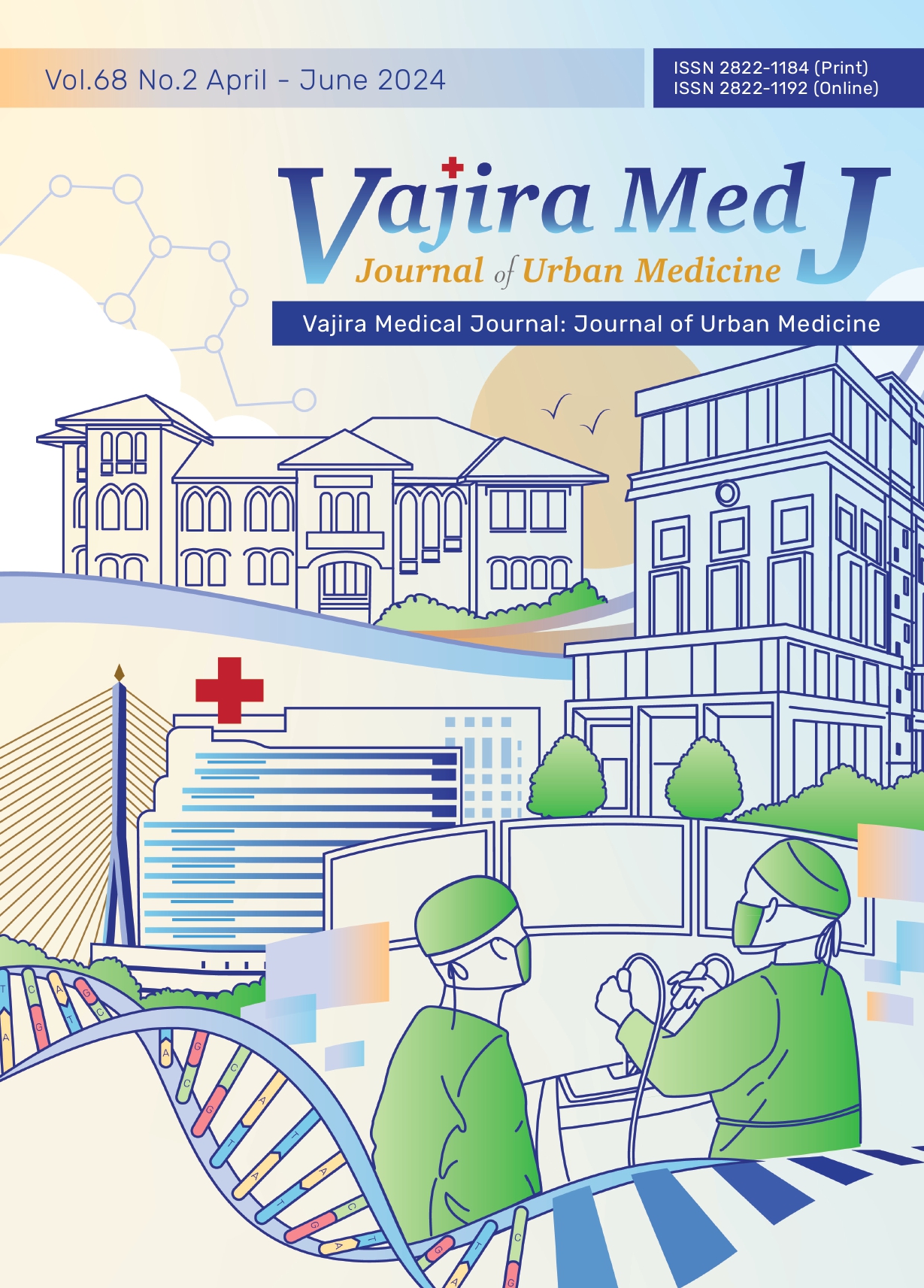Correlation between Various Factors and Pain in Gynecological Cancer Patients within the First 24 Hours Post-Operation: A Study in an Urban-Based Tertiary Medical Center Impacting Pain Factors in Gynecological Cancer Patients after Surgery
Main Article Content
Abstract
OBJECTIVE: To investigate various pain factors in patients with gynecological cancer who have undergone different types of elective hysterectomy.
METHODS: In this retrospective study, data on pain assessment were collected from gynecological cancer patients who underwent elective total abdominal hysterectomy or total laparoscopic hysterectomy surgeries (with associated surgery) between January 2019 and December 2022 at Vajira Hospital. The data were gathered starting from 24 hours after the procedures.
RESULTS: The pain assessment was evaluated using the Numerical Rating Scale (ranging from 0 to 10, representing low to severe pain) during the first 24 hours after the surgery. The results revealed that several factors, such as cancer location, prior surgical history, and body weight, influenced the intensity and onset of pain. However, different types of surgery did not have a significant impact on pain assessment. Moreover, patients with cancer lesions in the endometrium experienced an early onset of severe pain. Additionally, patients without previous surgical experience and those who are obese should receive additional attention in terms of pain management.
CONCLUSION: This study sheds light on evidence-based factors that influence pain intensity and/or pain onset, including cancer location, prior surgical history, and body mass index. Understanding these factors can contribute to more effective pain management strategies for gynecological patients’ post-surgery.
Downloads
Article Details

This work is licensed under a Creative Commons Attribution-NonCommercial-NoDerivatives 4.0 International License.
References
Ferlay J, Colombet M, Soerjomataram I, Parkin DM, Piñeros M, Znaor A, et al. Cancer statistics for the year 2020: an overview. Int J Cancer 2021;149(4):778–89.
International Agency for Research on Cancer. World Health Organization. Thailand global cancer observatory [internet]. 2022 [cited 2022 Nov 9]. Available from: https://gco.iarc.who.int/media/globocan/factsheets/populations/764-thailand-factsheet.pdf
National Cancer Institute. Types of cancer treatment [internet]. [cited 2022 Nov 9]. Available from: https://www.cancer.gov/about-cancer/treatment/types
McDonald ME, Ramirez PT, Munsell MF, Greer M, Burke WM, Naumann WT, et al. Physician pain and discomfort during minimally invasive gynecologic cancer surgery. Gynecol Oncol 2014;134(2):243-7.
Lee SH, Oh SR, Cho YJ, Han M, Park JW, Kim SJ, et al. Comparison of vaginal hysterectomy and laparoscopic hysterectomy: a systematic review and meta-analysis. BMC Womens Health 2019;19:83.
Aarts JW, Nieboer TE, Johnson N, Tavender E, Garry R, Mol BW, et al. Surgical approach to hysterectomy for benign gynaecological disease. Cochrane Database Syst Rev 2015;2015(8):CD003677.
Oranratanaphan S, Poolcharoen N, Aiyasriwatthana Ch, Worasethsin P. A comparative study of quality of life of patients who underwent total laparoscopic hysterectomy and total abdominal hysterectomy. Thai J Obstet Gynaecol 2019;27(2):57–64.
Kunapaisal Th, Pattaravit Ng, Thongsuksai P. Factors associated with moderate to severe pain after laparoscopic surgery. J Health Sci Med Res 2021;39(5):365-72.
Sarmini OR, Lefholz K, Froeschke HP. A comparison of laparoscopic supracervical hysterectomy and total abdominal hysterectomy outcomes. J Minim Invasive Gynecol 2005;12(2):121-4.
Lovich-Sapola J, Smith CE, Brandt CP. Postoperative pain control. Surg Clin North Am 2015;95(2):301-18.
Potter PA, Perry AG, Stockert P, Hall A. Fundamentals of nursing. 9th ed. London: Mosby; 2016.
Gerbershagen HJ, Rothaug J, Kalkman CJ, Meissner W. Determination of moderate-to-severe postoperative pain on the numeric rating scale: a cut-off point analysis applying four different methods. Br J Anaesth 2011;107(4):619-26.
Best Practice Committee of the Health Care Association of New Jersey. Pain management guideline [internet]. 2006 [cited 2022 Nov 9]. Available from: www.hcanj.org
Ndebea AS, van den Heuvel SAS, Temu R, Kaino MM, van Boekel RLM, Steegers MAH. Prevalence and risk factors for acute postoperative pain after elective orthopedic and general surgery at a tertiary referral hospital in Tanzania. J Pain Res 2020;13:3005-11.
Iamaroon A, Tangwiwat S, Nivatpumin P, Lertwacha Th, Rungmongkolsab P, Pangthipampai P. Risk factors for moderate to severe pain during the first 24 hours after laparoscopic bariatric surgery while receiving intravenous patient-controlled analgesia. Anesthesiol Res Pract 2019;2019:1–7.
Sanansilp V, Dejarkom S, Deetayart S. Postoperative pain management and the risk factors in major operation: a baseline study of acute pain service, Siriraj Hospital. J Med Assoc Thai 2016;99(5):549-56.
Munro A, Sjaus A, George RB. Anesthesia and analgesia for gynecological surgery. Curr Opin Anaesthesiol 2018;31(3):274-9.
Cruz JJ, Kather A, Nicolaus K, Rengsberger M, Mothes AR, Schleussner E, et al. Acute postoperative pain in 23 procedures of gynaecological surgery analysed in a prospective open registry study on risk factors and consequences for the patient. Sci Rep 2021;11:22148.
Leite Junior JB, de Mello Bastos JM, Samuels RI, Carey RJ, Carrera MP. Reversal of morphine conditioned behavior by an anti-dopaminergic post-trial drug treatment during re-consolidation. Behav Brain Res 2019;359:771-82.
Lamvu G, Feranec J, Blanton E. Perioperative pain management: an update for obstetriciangynecologists. Am J Obstet Gynecol 2018;218(2):193-9.
Gauta J. Outpatient laparoscopic hysterectomy: evaluation of pain. J Soc Laparoendosc Surg 2011;15(3):346–9.
Caraceni A, Shkodra M. Cancer pain assessment and classification. Cancers (Basel) 2019;11(4):510.
Honerlaw KR, Rumble ME, Rose SL, Coe CL, Costanzo ES. Biopsychosocial predictors of pain among women recovering from surgery for endometrial cancer. Gynecol Oncol 2016;140(2):301-6.
Bradshaw P, Hariharan S, Chen D. Does preoperative psychological status of patients affect postoperative pain? A prospective study from the Caribbean. Br J Pain 2016;10(2):108-15.
Smart KM, Hinwood NS, Dunlevy C, Doody CM, Blake C, Fullen BM, et al. Multidimensional pain profiling in people living with obesity and attending weight management services: a protocol for a longitudinal cohort study. BMJ Open 2022;12(12):e065188.
Basem JI, White RS, Chen SA, Mauer E, Steinkamp ML, Inturrisi CE, et al. The effect of obesity on pain severity and pain interference. Pain Manag 2021;11(5):571-81.
Torensma B, Oudejans L, van Velzen M, Swank D, Niesters M, Dahan A. Pain sensitivity and pain scoring in patients with morbid obesity. Surg Obes Relat Dis 2017;13(5):788-95.


